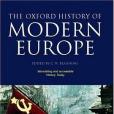內容簡介
Book Description
Written by eleven contributors of international standing, this book offers a readable and authoritative account of Europe's turbulent history from the French Revolution in the late eighteenth century to the present day. Each chapter portrays both change and continuity, revolutions and stability, and covers the political, economic, social, cultural, and military life of Europe. This book provides a better understanding of modern Europe, how it came to be what it is, and where it may be going in the future.
Review
"In the introduction to the Oxford Illustrated History of Modern Europe, T.C.W. Blanning argues that, in many ways, the essence of modern man is that he is self-consciously dynamic. We are attracted to change--it captures the eye much more than stability. This excellent book reveals much about the things that have changed in Europe since 1789--and, just as importantly, the things that have remained constant. The eleven essays in this collection (written by some of the biggest names in the field of European history, such as Princeton's Harold James, U.C. Berkeley's Martin Jay, and Richard Overy of King's College, London) focus on various aspects of European society, from politics and economics to high culture and social structures, and analyze both the changes and the engines of those changes. In his standout essay on the changing nature of warfare, 1789-1918, Hew Strachan argues that this military modernization cannot simply be explained by new technology and that more emphasis must be placed on changing ideas. Strachan and the other authors for the most part eschew jargon and present an authoritative set of essays complemented by over 240 arresting color and black-and-white illustrations. Many of the chapters would be suitable readings for upper-division history courses, and the thorough index, detailed chronology, and suggestions for further reading would be a great help to students. This book is accessible to the general reader while remaining valuable to the scholar--and is immensely readable to boot." --C.B. Delaney
"The French Revolution instituted a period of political and social change that still affects Europe today. This volume presents 12 interpretive essays by leading U.S. and British scholars covering politics, economics, warfare, class structure, art, and culture from the time of the revolution through 1995. Central themes include the idea that revolution against established order was possible, successful, and, once underway, perhaps unstoppable. The idea of radical change also had a huge impact on the intellectual and cultural life as reflected in the art and literature of the period. Science and technology reinforced this concept by spreading industrialization throughout the Continent. Although science increased the life span of the overall population, many lived in poor conditions and fell victim to increasingly bloody warfare. The 20th century saw Europe divided among democratic capitalism, fascism, and communism and subject to two horrific wars. The collapse of the Soviet bloc in 1989, 200 years after the beginning of the French Revolution, eliminated one ideological barrier but left numerous unsolved problems. Combined with these well-written essays are photographs, reproductions, drawings, and maps that augment the authors' arguments. This work complements more detailed works such as Theodore S. Hamerow's Birth of a New Europe (LJ 10/1/83), Roland Stromberg's After Everything: Western Intellectual History Since 1945 (1975), and Walter Laqueur's Europe in Our Time (LJ 12/91). It presents current scholarship and social criticism on the development of modern European society in a readable manner suitable for all academic and public libraries." -- Stephen L. Hupp, Univ. of Pittsburgh-Johnstown, Pa. Library Journal
"No sentence is superfluous in this topical overview of the two revolutionary centuries since 1789. Verbal economy being its hallmark, the edition leaves plenty of room for illustrations (starting with the dust jacket, the dramatic 1945 image of the Soviet banner atop the Reichstag) that powerfully emphasize what Blanning's 10 authors interpret about economics, politics, culture, class and family, and other areas. Each subject encloses modernity, the embrace of change or the rejection of it. Two chapters treat of modernity in the arts (on the replacement of aristocratic patronage by commercialism and on this century's fragmentation of visual arts into idiosyncratic groups, like the dadaists). The big change visible to all was industrialism, depicted here in contemporary paintings of blast furnaces and railroads. The effect on military technology warrants two chapters, halved by 1918, while political currents from monarchism to nationalism to communism to fascism also receive their judicious due. As usual from Oxford, a balanced, attractive one-volume resource" -- Gilbert Taylor, Booklist

